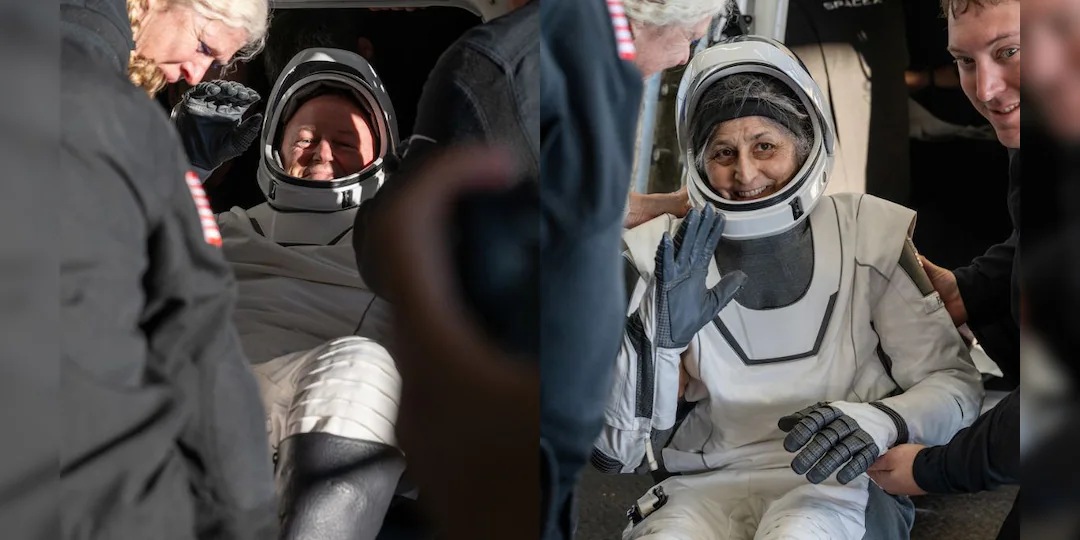🚀 Sunita Williams Returns to Earth After Unexpected 9-Month ISS Stay
NASA astronaut Sunita Williams, along with her Crew-9 teammates, has successfully returned to Earth
after a prolonged nine-month mission aboard the International Space Station (ISS). Originally scheduled
for just an eight-day trip, their stay was extended due to technical issues with Boeing’s Starliner spacecraft.
This mission highlighted both the challenges of space travel and the resilience of astronauts, who conducted
groundbreaking experiments in microgravity while awaiting a safe return plan. Williams, a veteran astronaut of Indian
origin, has once again made history, leaving an indelible mark on space exploration.
🚀 The Return Journey
The Crew Dragon capsule carrying Williams, Butch Wilmore, Nick Hague, and Aleksandr Gorbunov
successfully undocked from the ISS at 11:05 p.m. ET on Monday. Before departure, the crew conducted
final system checks, donned flight suits, and secured themselves in their seats.
The 17-hour journey back to Earth was closely monitored by NASA and SpaceX. Upon re-entry, the
capsule endured extreme temperatures before deploying parachutes for a smooth splashdown in the Gulf of Mexico
at 5:57 p.m. ET on Tuesday.
Recovery teams swiftly retrieved the crew, ensuring their safe transport to Houston’s Johnson Space Center,
where medical teams awaited to assess their health.
🩺 45-Day Rehabilitation
After spending nine months in microgravity, astronauts experience muscle atrophy, bone density loss, and
fluid shifts. Williams and Wilmore have now entered an intensive 45-day rehabilitation program, which includes:
- 🏋️♂️ Strength Training: To rebuild muscle lost in zero gravity.
- 🧘♀️ Balance & Coordination Exercises: Countering dizziness and post-flight disorientation.
- 🩺 Medical Monitoring: Tracking cardiovascular changes and bone regeneration.
- ⚡ Nutritional Recovery: Adjusting to Earth-based digestion and hydration patterns.
NASA’s rehabilitation specialists will monitor their progress to ensure a full recovery.
🔬 Scientific Contributions
During their extended stay, the Crew-9 team conducted critical research that could impact future space exploration
and medical science. Notable experiments included:
- 🧬 DNA Sequencing in Microgravity: Studying genetic changes in space environments.
- 🌱 Plant Growth in Space: Research on sustainable food production for deep-space missions.
- 🔋 Advanced Battery Testing: Evaluating power storage technologies for lunar and Mars missions.
- 💉 Medical Research: Studying the effects of microgravity on human immune systems and aging.
These findings will contribute to NASA’s long-term Artemis Program, which aims to send astronauts to the Moon and Mars.
🏛️ Political Reactions
The mission’s conclusion drew political commentary, reflecting the growing role of space exploration in global affairs:
- 🇮🇳 PM Narendra Modi: “Welcome back, #Crew9! Your perseverance inspires millions.”
- 🇺🇸 NASA & White House: Highlighted the success of private-public partnerships in space.
- 🇷🇺 Russian Cosmonaut Program: Emphasized the importance of international cooperation aboard the ISS.
- 🚀 Boeing vs. SpaceX: The Starliner delays reignited debates on private-sector competition in spaceflight.
The mission’s extended duration also raised concerns about commercial spaceflight reliability, influencing future policies.
🔮 Future of Space Missions
The unexpected extension of Crew-9’s mission revealed critical lessons for future deep-space missions:
- 🛠️ Redundancy in Spacecraft Systems: Enhancing backup return options.
- 👨🚀 Astronaut Endurance Training: Preparing crews for unexpected long-term stays.
- 🚀 Advancements in AI-Driven Monitoring: Improving spacecraft health diagnostics.
- 🌍 International Cooperation: Strengthening collaboration for long-duration space missions.
NASA and its partners, including ISRO, ESA, and Roscosmos, are incorporating these findings into upcoming Mars
and lunar exploration projects.
💡 Final Thoughts
Sunita Williams’ remarkable journey showcases the resilience of human spaceflight and the growing role of private
space companies in global exploration efforts.
Her story serves as a reminder that space is not just for astronauts—it’s for all of humanity, pushing the boundaries
of what’s possible.
🔗 For more updates, visit the official NASA website.
